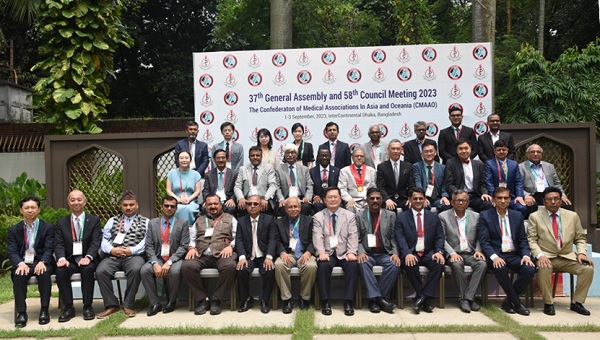There have been 153 weekly Zoom sessions under the auspices of the Confederation of Medical Associations in Asia and Oceania (CMAAO) in the last three years. The online meetings originated with the late Dr KK Aggarwal who started these meetings during the dark, early days of the COVID-19 pandemic. Unfortunately, he succumbed to COVID-19 in May 2021.
The CMAAO is a federation of 18 medical associations comprising the Indian subcontinent, the Association of Southeast Asian Nations, Hong Kong, Taiwan, Japan, Korea and Australia. Our Zoom meetings were also joined by doctors in Brazil, the United States and South Africa.
Meeting in person
We had previously met in Karachi, Pakistan in September 2022 via a hybrid meeting. This time, we were glad to conduct a physical meeting in Dhaka, Bangladesh attended by representatives from nine national medical associations (NMAs): Hong Kong, India, Japan, Korea, Malaysia, Nepal, Pakistan, the Philippines and Singapore.
I flew to Dhaka by direct flight from Singapore and it was heartwarming to meet up with colleagues, especially those from Japan and Korea, whom we have been meeting only virtually for three years.
Our meeting was also graced by Dr Park Jung Yul, Chair of Council, World Medical Association (WMA) and Dr Osahon Enabulele, President, WMA.
Learning from one another
We had our annual CMAAO General Assembly from 1 to 3 September, and the meeting also encompassed symposiums on the topic of "Primary Care" which included the prestigious Takemi Taro oration, delivered this year by Bangladesh Medical Association President Dr Mustafa Jalal Mohiuddin. Dr Taro Takemi was the President of the Japan Medical Association from 1957 to 1982. Venerated for his leadership, Dr Takemi was instrumental in the founding of CMAAO.
The symposium saw each nation present their take on primary care. It was fascinating to listen to the country reports of each NMA, and the various representatives delivered insights into how their countries handle the challenges of child and maternal care, endemic infections and non-communicable diseases.
We took the opportunity to learn from each other when we shared our areas of difficulties, how we resolved certain issues and how we interacted with our respective governments. The meeting ended with the Dhaka declaration entitled "Pandemic Preparedness is built upon a robust primary healthcare system". In particular, I must single out the innovative "Community Clinic" model in Bangladesh that has been very successful and touted by the United Nations as an exemplary model for developing countries.
Under this model, the land for the clinic is provided by the community it serves, while the building, infrastructure, medications, vaccines, equipment as well as the training and salaries of the healthcare workers who run the clinic are all paid for by the government. The clinic's emphasis is on child and maternal care including diarrhoeal and respiratory diseases, childhood vaccinations, and antenatal care including deliveries by midwives in 20 percent of these clinics across the nation. The clinic's healthcare workers can also take patients' blood pressure and use glucometers to detect hypertension and diabetes. Serious ailments are escalated to the next level of care which involves doctors in regional centres.
Experiencing the city
Dhaka is a city of 23 million people and the traffic, as with these megacities, is chaotic. The roads are packed with cars, trishaws, petrol-driven three-wheelers, buses, pedal-powered goods carts coupled with pedestrians crossing indiscriminately at their own risk. There are 1.8 million registered vehicles on the roads. During the time we were there, there was the official opening of a highway from the international airport to our hotel. I enjoyed the highway journey from my hotel to the airport, which took only ten minutes. Unfortunately, the ride from my hotel to the highway ramp was three kilometres and the journey took two hours.
We were also struck by the history of Bangladesh and how it was led to independence by Sheikh Mujibur Rahman, father of the current prime minister Sheikh Hasina. He was a charismatic man and won the general election in 1970; the ruling junta, however, refused to yield to him. His speech on 7 March 1971 announced the independence movement and led to a war for independence. We were brought to his family home where he and most of his family were massacred in a coup in 1975, and which has since been turned into a memorial museum. His two daughters, including the current prime minister, were abroad at that time. The family home is preserved in its original condition with bullet holes still seen in the walls. Prime Minister Sheikh Hasina occasionally comes back to visit and sit in her old bedroom which is closed to the public.
Interestingly, Dr Enabulele shared the poignant thought that his politician father had also been shot by assassins when he was 15 years old. I could see that he was very moved by the visit to the family home of Sheikh Mujibur Rahman.
It was certainly a meeting that we would not forget for a long while, and we were indeed overwhelmed by the kindness and generosity of our hosts and the emotional meeting with people whom we have met online year after year. It was with heavy hearts when it came time to take our leave, but we were cheered by the thought of meeting up in Manila in 2024 for our next General Assembly.

Delegates pose for a group photo